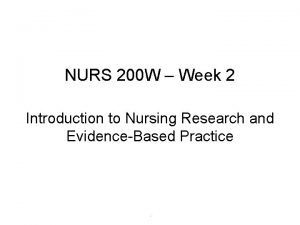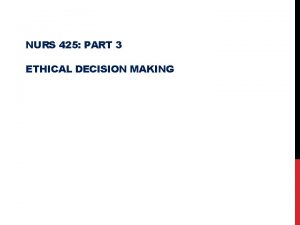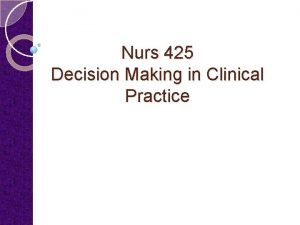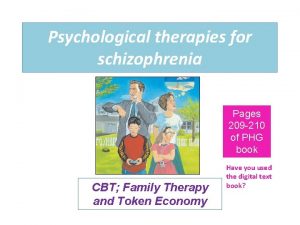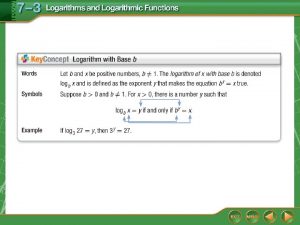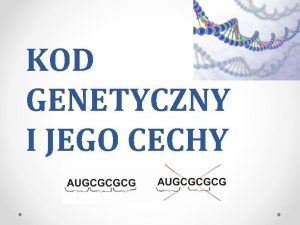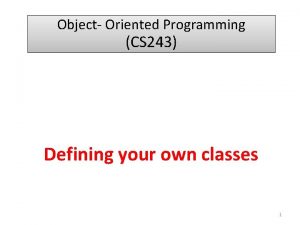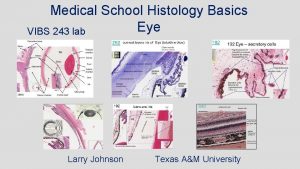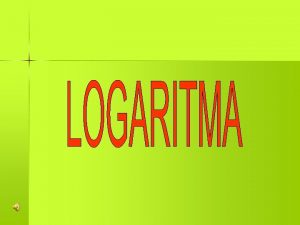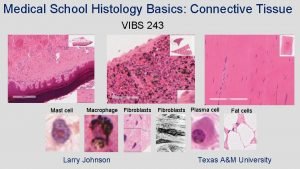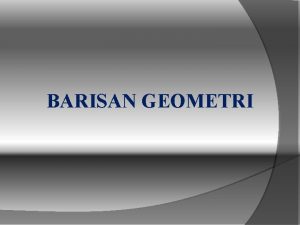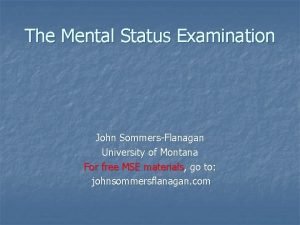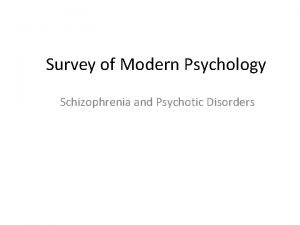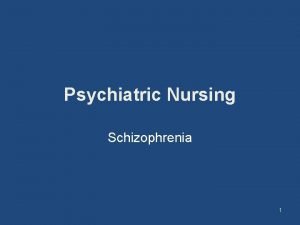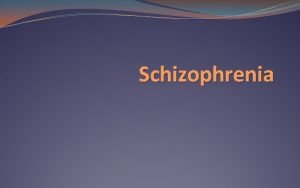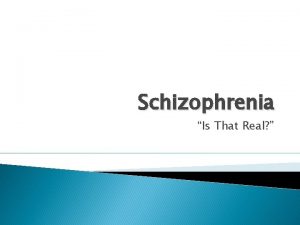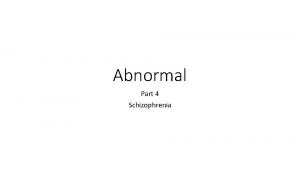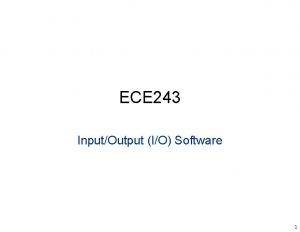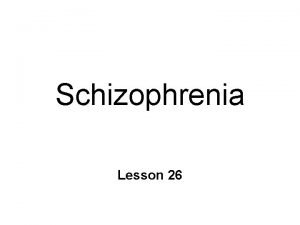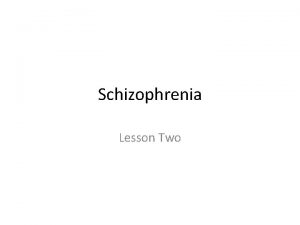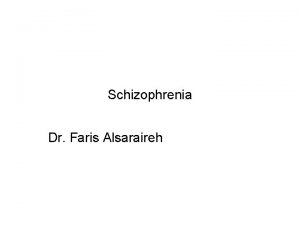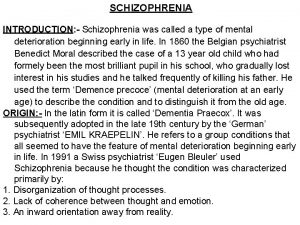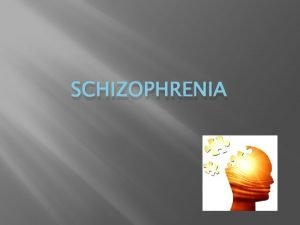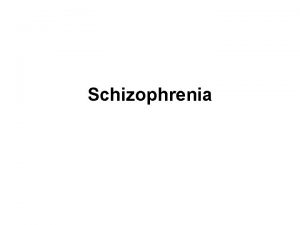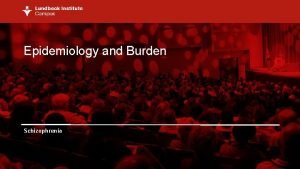Schizophrenia NURS 243 Lesson Two Introduction Schizophrenia is
























- Slides: 24

Schizophrenia NURS 243 Lesson Two

Introduction Schizophrenia is a syndrome or disease process of the brain that causing distorted and bizarre thoughts, perceptions, emotions, movements, and behavior. p It is usually diagnosed in late adolescence and early adulthood (15 to – 25 years for men, 25 to – 35 years for women). p Prevalence is 1% of the total population, or 3 million in the U. S. ; same prevalence throughout the world. p

Symptoms p Hard, or positive symptoms, are amenable to antipsychotic medication and include: n n n Delusions Hallucinations Grossly disorganized thinking, speech, and behavior.

Symptoms p Soft, or negative symptoms, persist over time and are somewhat amenable to atypical antipsychotics only. They include: n n n Flat affect Lack of volition Social withdrawal or discomfort Apathy Alogia

Types of Schizophrenia p p p Paranoid type: persecutory or grandiose delusions and hallucinations; sometimes excessive religiosity; hostile and aggressive behavior Disorganized type: grossly inappropriate or flat affect, incoherence, loose associations, extremely disorganized behavior Catatonic type: marked psychomotor disturbance, ; motionless or excessive motor activity, ; extreme negativism, mutism, ; peculiarities of voluntary movement (echolalia, echopraxia) Undifferentiated type: mixed schizophrenic symptoms along with disturbances of thought, affect, and behavior Residual: at least one previous psychotic episode but not currently; social withdrawal, ; flat affect, ; loose associations

Clinical Course p p p Varies among clients Most clients experience a slow and gradual onset of symptoms. Younger age of onset associated with poorer outcomes In first years after diagnosis, client may have relatively symptom-free periods between psychotic episodes or fairly continuous psychosis with some shift in severity of symptoms. Over the long term, psychotic symptoms diminish for most clients and are managed more easily. Many years of dysfunction are rarely overcome.

Related Disorders p p p Schizophreniform disorder: symptoms of schizophrenia are experienced for less than the 6 months required for a diagnosis of schizophrenia Schizoaffective disorder: symptoms of psychosis and thought disorder, along with all the features of a mood disorder Delusional disorder: one or more nonbizarre delusions with no impairment in psychosocial functioning Brief psychotic disorder: one psychotic symptoms lasting 1 day to 1 month; may or may not have an identifiable stressor, such as childbirth Shared psychotic disorder (folie à<aga>deux): similar delusion shared by two people, one of whom has psychotic delusions Do not confuse schizoid personality disorder and schizotypal personality disorder with schizophrenia or related disorders.

Etiology p Current etiologic theories focus on biologic theories. n n Genetic factors indicate that identical twins have a concordance rate of 50% for schizophrenia; fraternal twins have a 15% concordance rate. One biologic parent with schizophrenia results in a 15% risk for child; having two parents with schizophrenia carries a 35% risk. Neuroanatomic theories are based on research showing that persons with schizophrenia have less brain tissue, enlarged ventricles in the brain, cortical atrophy, and diminished oxygen and glucose metabolism. Neurochemical theories postulate that excess dopamine is a causative factor. Drugs that block dopamine receptors reduce psychotic (positive) symptoms. Excessive serotonin may also play a role in schizophrenia, causing many of the negative symptoms. Immunovirologic factors include exposure to a virus (such as flu) or the body’s response to a virus that alters brain pathology.

Cultural Considerations p p p Be aware of different cultural norms. Assessment of affect using eye contact, body language, appropriate emotional responses. Studies have shown that African Americans and Asians are diagnosed with schizophrenia more often than whites. Latinos were diagnosed less often than whites (when all other factors are controlled). Culture-bound syndromes occur throughout the world and must be considered when working with a client of a different culture. Ethnicity affects a client’s response to medications, due to rates of metabolism of certain drugs. African Americans, Hispanics, and whites all require similar doses of antipsychotics to produce similar effects, but Asians require much lower doses. Asians have more side effects if given standard doses

Treatment p Primary treatment of schizophrenia is neuroleptic or antipsychotic medication.

Conventional Antipsychotics p p Dopamine antagonists: Fluphenazine (Prolixin) and haloperidol (Haldol) are two typical antipsychotics available in depot injection form. These preparations are based in sesame oil, which absorbs slowly over time (Haldol 4 weeks; Prolixin 7 to – 28 days), so injections are needed every 1 to – 4 weeks; usually prescribed for clients who have difficulty with compliance. Atypical Antipsychotics: Dopamine antagonists, inhibition of serotonin reuptake

Side Effects p Antipsychotic medications have many significant side effects. n n n Extrapyramidal side effects include dystonic reactions, pseudoparkinsonism, and akathisia. All are reversible and can be treated with anticholinergic medications. Tardive dyskinesia is a late-appearing, irreversible abnormal movement disorder; prevention or early detection is necessary. Seizures occur infrequently and stop when medication is discontinued. Neuroleptic malignant syndrome is a frequently fatal side effect characterized by muscle rigidity, high fever, elevated CPK; stop drug immediately. Clozapine (Clozaril) can cause agranulocytosis, so regular WBC counts are required

Adjunctive Treatment Individual, group, and family therapy p Structured milieu therapy p Community support programs p Client/family education and support p

Application of the Nursing Process p Assessment n n n Previous hospitalizations Presence of suicidal ideation Current support system Client’s perception, appearance, odd or bizarre speech or motor behavior General appearance and motor behavior Mood and affect: flat or blunted affect, anhedonia Thought processes and content: delusions Sensorium and intellectual processes: hallucinations, ; concrete or literal thinking Judgment and insight: impaired judgment, limited insight Self-concept: may be distorted, with depersonalization, loss of ego boundaries resulting in bizarre behaviors Roles and relationships: often socially isolated, ; have difficulty fulfilling life roles Physiologic and self-care considerations, : may have multiple self-care deficits (inattention to hygiene, nutrition, sleep needs; polydipsia occasionally seen in longer-term clients)

Application of the Nursing Process p Data Analysis: Common nursing diagnoses for positive symptoms include: n n n Risk for Other-Directed Violence Risk for Suicide Disturbed Thought Processes Disturbed Sensory Perception Disturbed Personal Identity Impaired Verbal Communication

Application of the Nursing Process p Nursing diagnoses for negative symptoms and functional abilities include: n n n Self-Care Deficits Social Isolation Deficient Diversional Activity Ineffective Health Maintenance Ineffective Therapeutic Regimen Management

Application of the Nursing Process p Outcome Identification: Expected outcomes for the acute, psychotic phase include the client will: n n n Not injuring self or others. Establishing contact with reality. Interacting with others. Expressing thoughts and feelings in a safe and socially acceptable manner. Participating in prescribed therapeutic interventions.

Application of the Nursing Process p Expected outcomes for continued care include the client will: n n n Participating in the prescribed regiment (including medication and follow-up appointments). Maintaining adequate routines for sleeping and food and fluid intake. Being independent in self-care activities. Communicating effectively with others in the community to meet his or her needs. Seeking or accepting assistance to meet his or her needs when indicated.

Application of the Nursing Process p Intervention n n n Promote safety of clients and others: being nonthreatening, ; allow personal space, ; observe for signs of increasing agitation or anxiety so that prn medication as required or a quiet environment can be offered; avoid physical acting-out behavior that might necessitate restraint or seclusion Establish a therapeutic relationship: short, frequent contacts, ; clear explanations, ; reality orientation, ; careful use of touch, ; spending time with client, ; active listening, ; clarifying statements Interventions for delusional thoughts: presenting reality, ; casting doubt; using diversional techniques; avoiding direct confrontation; playing along with the delusion Interventions for hallucinations: focusing on reality; presenting reality; helping client identify feelings; reality-based activities; engaging client in environment. Protecting the client who has socially inappropriate behaviors: providing for privacy, and dignity, and safety from other clients, ; redirecting client to appropriate behavior, ; engaging client in activities, ; reassuring the family and other clients Client and family teaching includes management of the illness, prevention of relapse, proper self-care and nutrition (no alcohol or other drugs), social skills, importance of community-based activities and support groups

Application of the Nursing Process p Evaluation n n Absence of symptoms or ability to function despite ongoing symptoms Understanding and agreement with medication regimen Functional abilities for community living Plan for crisis occurrence Client satisfaction with quality of life

Community-Based Care Assertive community treatment (ACT) p Behavioral home health p Community support programs p Case management p

Mental Health Promotion Psychiatric rehabilitation has the goal of recovery for the client, more than just symptom control and medication management. p Early identification and aggressive treatment of psychotic symptoms maximizes recovery and quality of life. p Research study to treat genetically vulnerable relatives with beginning negative signs of schizophrenia before psychosis develops. p

Self-Awareness Issues p p p May be challenging if client is suspicious or mistrustful or nurse is frightened Nurse may become frustrated if client is noncompliant. Nurse must not take client’s success or failure personally. The client’s remarks and behavior or noncompliance are not personal toward the nurse; part of the illness. Focus on client’s strengths and time out of the hospital, not just on symptoms and need for acute care. No nurse has all the answers.

Next Steps… p After completing this section of the lesson, go on to the next step…
 Nurs 200
Nurs 200 Nurs 425
Nurs 425 Nurs 425
Nurs 425 Two years ago jenny was diagnosed with schizophrenia
Two years ago jenny was diagnosed with schizophrenia Scuri ulisse
Scuri ulisse Log3 9=2 in exponential form
Log3 9=2 in exponential form Kod genetyczny jednoznaczny
Kod genetyczny jednoznaczny Article 243x
Article 243x Article 243
Article 243 243 kpk
243 kpk Cs 243
Cs 243 Vibs histology
Vibs histology Nilai x dari 3ˣ = 81 adalah
Nilai x dari 3ˣ = 81 adalah Przedszkole nr 243
Przedszkole nr 243 Przedszkole 243
Przedszkole 243 Pangkat 2 log 50 + pangkat 2 log 8 - pangkat 2 log 100
Pangkat 2 log 50 + pangkat 2 log 8 - pangkat 2 log 100 Nwen 243
Nwen 243 Muscular artery
Muscular artery Jika diketahui log 2
Jika diketahui log 2 Nwen 243
Nwen 243 243 ida
243 ida Definisi barisan geometri
Definisi barisan geometri Mse sample report
Mse sample report Delusional disorder
Delusional disorder Signs of schizophrenia in children
Signs of schizophrenia in children
